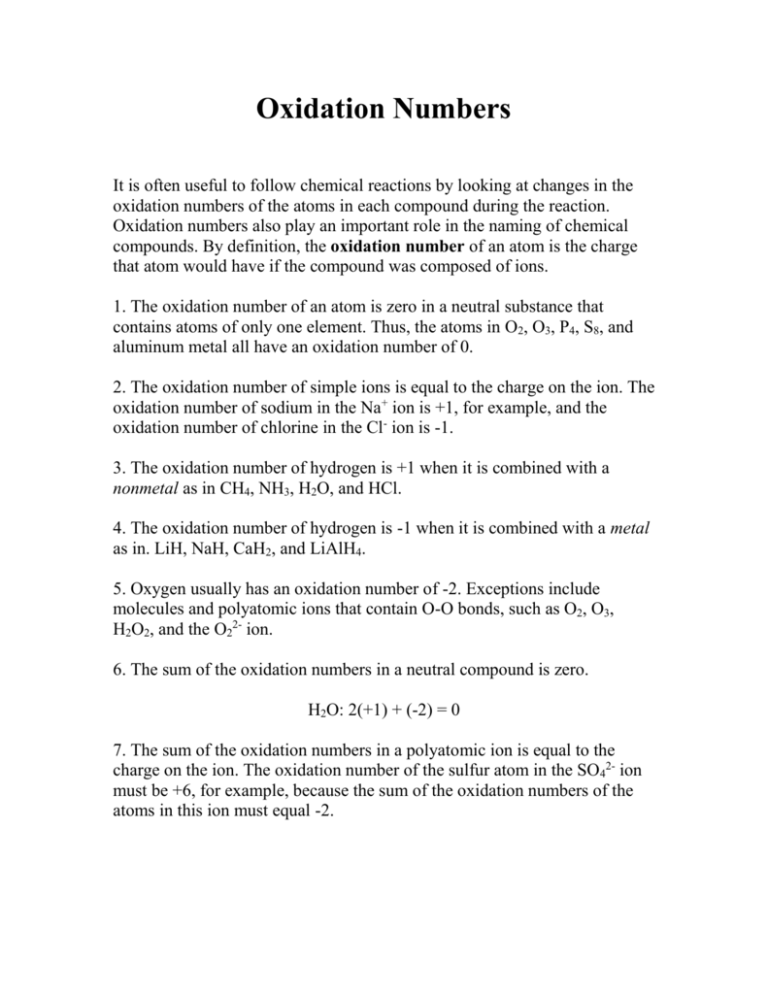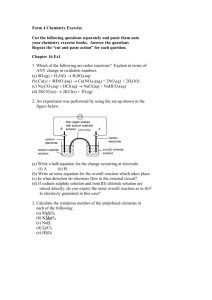doc: Oxidation Numbers
advertisement

Oxidation Numbers It is often useful to follow chemical reactions by looking at changes in the oxidation numbers of the atoms in each compound during the reaction. Oxidation numbers also play an important role in the naming of chemical compounds. By definition, the oxidation number of an atom is the charge that atom would have if the compound was composed of ions. 1. The oxidation number of an atom is zero in a neutral substance that contains atoms of only one element. Thus, the atoms in O2, O3, P4, S8, and aluminum metal all have an oxidation number of 0. 2. The oxidation number of simple ions is equal to the charge on the ion. The oxidation number of sodium in the Na+ ion is +1, for example, and the oxidation number of chlorine in the Cl- ion is -1. 3. The oxidation number of hydrogen is +1 when it is combined with a nonmetal as in CH4, NH3, H2O, and HCl. 4. The oxidation number of hydrogen is -1 when it is combined with a metal as in. LiH, NaH, CaH2, and LiAlH4. 5. Oxygen usually has an oxidation number of -2. Exceptions include molecules and polyatomic ions that contain O-O bonds, such as O2, O3, H2O2, and the O22- ion. 6. The sum of the oxidation numbers in a neutral compound is zero. H2O: 2(+1) + (-2) = 0 7. The sum of the oxidation numbers in a polyatomic ion is equal to the charge on the ion. The oxidation number of the sulfur atom in the SO42- ion must be +6, for example, because the sum of the oxidation numbers of the atoms in this ion must equal -2. ASSIGNING OXIDATION NUMBERS: Practice Problem Set #1: Use the rules to determine the oxidation number of the element in bold in each formula. Formula: Work answer 1. Sb2O5 2. Al(NO3)3 3.Mg3(PO4)2 4. NH4)2SO4 5. CrO4-2 6. ClO47. NaBO3 8. MgSiF6 9. IO310.(NH4)2S 11. MnO4 12. BrO3 13. ClO 14. Cr2O7 -2 2x + 5(-2)= 0 2x -10=0 2x = 10 x=+5 +5 15. H2SeO3 CHARTING REDUCING AGENTS AND OXIDIZING AGENTS Practice Problems Set #2: For each reaction below, draw arrows and show electron numbers as in the example here. The top arrow indicates the element that gains electrons, reduction, and the bottom arrow indicates the element that looses electrons, oxidation. 1. Mg + O2 MgO 2. Cl2 + I - Cl - + I2 3. MnO4 - + C2O4 -2 Mn+2 + CO2 4. Cr + NO2 - CrO2 - + N2O2 -2 5. BrO3 - + MnO2 Br - + MnO4 6. Fe+2 + MnO4 - Mn+2 + Fe+3 7. Cr + Sn+4 Cr+3 + Sn+2 8. NO3 - + S NO2 + H2SO4 9. IO4- + I - I2 10. NO2 + ClO - NO3 - + Cl -







